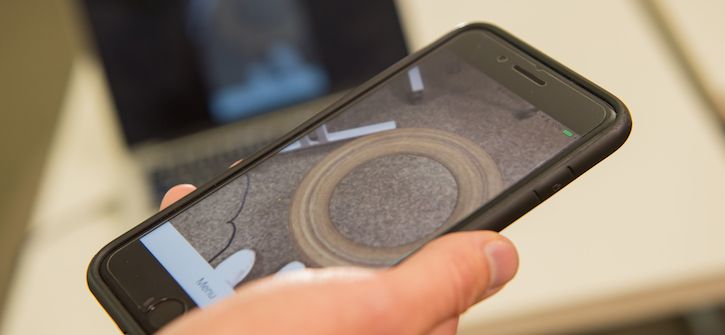Could Augmented Reality Help Fight Parkinson's-related "Freezing"?
A team of students at Rice University developed an app that uses visual cues to mitigate that vexing symptom.

Image courtesy Rice University. Image has been cropped for size.
Studies have found that many people with Parkinson’s disease try to shroud their symptoms out of social fear. That obviously isn’t a good thing: Everyone deserves to make it through their day, or at least down the street, without fearing how their motions may look to others.
A team of Rice University engineering students have designed a system that might help those with the disease get through one of its most vexing symptoms in a way that’s pretty discreet in today’s society: By staring at a smartphone screen.
The phenomenon known as “freezing” occurs for many Parkinson’s patients. It’s when their limbs temporarily won’t do what their brain is telling them to, causing them to “freeze” during activities like walking. Sometimes, a simple visual cue can help spur their motion.
That’s where augmented reality (AR) comes in. The students developed a smartphone app that allows a user to place one of those cues, like a circle or block (see image above), to target where on the ground their next step should land . According to a brief from Rice, the cue is often enough to spur patients back into their gait.
“This is for patients who, in their day-to-day lives, experience freezing episodes,” one team member, Gaby Perez, said. The app can also use tactile and audio cues, which Perez said other devices meant to assist with the problem typically don’t incorporate.
A smartphone app is also cheaper and more innocuous than those other solutions, like laser-guiding canes. One of Perez’s teammates, Dan Burke, said that the project “has the potential to work more effectively and at a fraction of the cost.” The app—which is more proof-of-concept than eventual product—was designed for iPhones, but the team said it should be adaptable to Android devices as well.
To help assist patients who may suffer from Parkinson’s-related tremors, the team helped design a lanyard phone holder that can make the device easier to hold. There’s been a lot of recent research on this front, too: A team in Finland just released a study about an optimizer they’d developed that uses artificial intelligence to create smartphone interfaces for people with various symptoms (including tremors) that can make touchscreens difficult to use. Another new study from Johns Hopkins University detailed an mHealth app developed to track Parkinson’s disease progression based on
The team at Rice—which calls itself Stairway to Stability—said that many of the patients they worked with are experiencing milder Parkinson’s symptoms, but that the freezing problem already affected all of them in some way.
“They’ve each talked about the mental gymnastics they go through to be able to move their feet again. They’re very interested in anything that can reduce that burden,” team member Keshev Rao said. His colleague, Kristen Smith, added that a discreet solution was one of their main goals.
Related Coverage:
Want Better Treatments for Parkinson's Disease? Smartphones Can Help
Computer Models Used to Predict Progression of Parkinson's Disease in Patients
AI Can Tailor Touchscreens for Those With Disabilities
Podcast: Adoption of Healthcare Tech in the Age of COVID-19 with Dr Kaveh Safavi
June 22nd 2021Kaveh Safavi, MD, JD, global health lead of Accenture Health, discusses how the pandemic influenced the speed at which healthcare organizations adopted new technologies and how this adoption is impacting patient care.
Podcast: Adoption of Healthcare Tech in the Age of COVID-19 with Dr Kaveh Safavi
June 22nd 2021Kaveh Safavi, MD, JD, global health lead of Accenture Health, discusses how the pandemic influenced the speed at which healthcare organizations adopted new technologies and how this adoption is impacting patient care.
2 Commerce Drive
Cranbury, NJ 08512
All rights reserved.